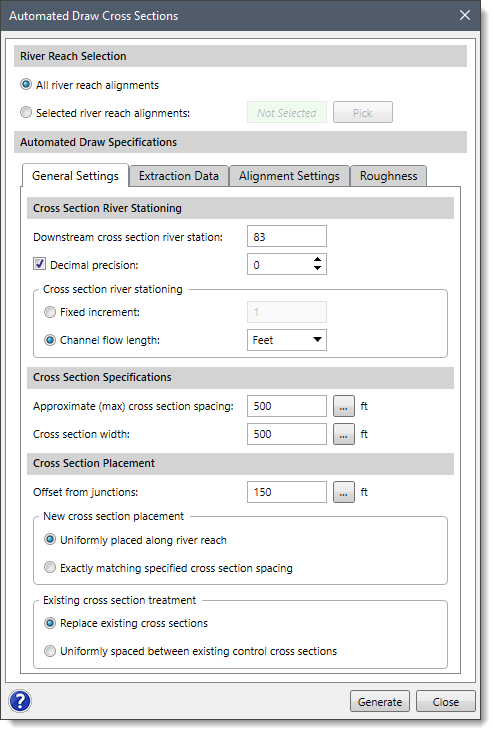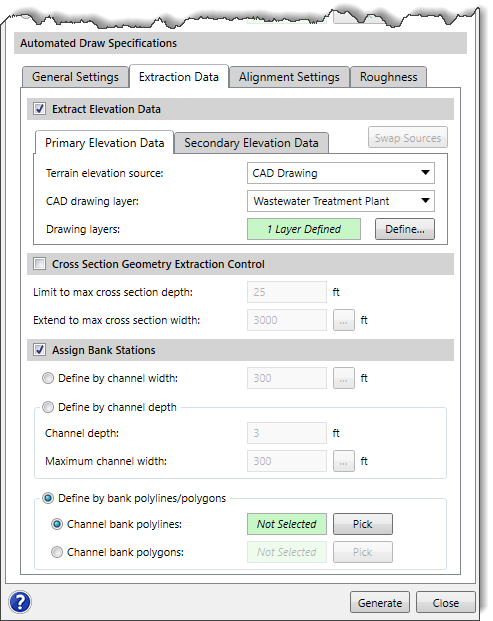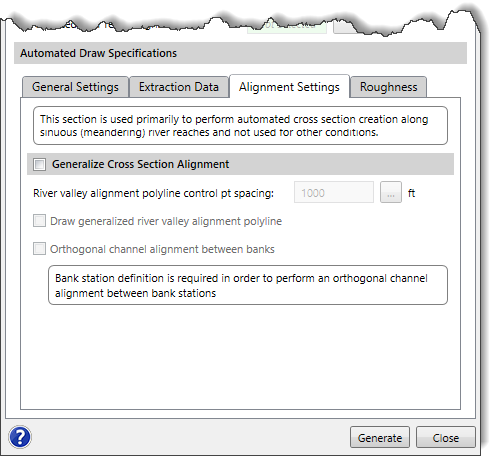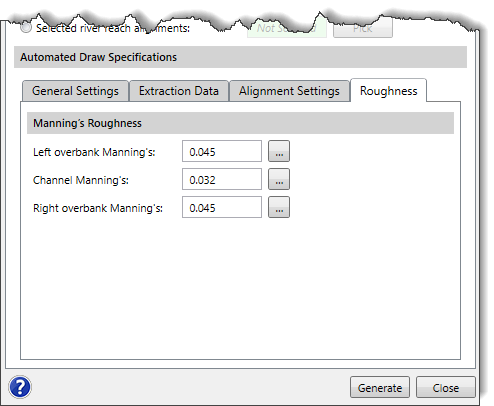
Welcome to CivilGEO Knowledge Base
Welcome to CivilGEO Knowledge Base

Welcome to CivilGEO Knowledge Base
Welcome to CivilGEO Knowledge Base
The Automated Draw Cross Sections command of GeoHECRAS software allows the user to automatically create cross sections along a river reach. The software will attempt to uniformly space cross sections along the river reach, creating cross sections that are perpendicular to the river reach. In places where adjoining cross sections might cross each other, the software will intelligently bisect the cross section point of intersection and then run the adjoining cross sections parallel to each other.
Follow the steps below to use the Automated Draw Cross Sections command in GeoHECRAS:


The following sections describe the Automated Draw Cross Sections command and how to interact with the above dialog box.
This section is used to select the river reach(es) that will be used to automatically draw cross sections. The following options are provided:
Note that if river reach(es) have been preselected on the Map View before running this command, the number of selected river reach(es) will be displayed in the Selected river reach alignments read-only field.
This tabbed panel is used to define the general settings for the cross sections to be created.
This section controls the numbering of the cross section river stations. The cross section river stations need to be unique per river reach and need to increase in value as they move up the river reach. The following entries are provided:

This section is used to define the general specifications for the cross sections to be created. The following entries are provided:
Note that the Cross section width field is ignored if the user has enabled the Cross Section Geometry Extraction Control section from the Extraction Data panel.
This section is used to define the placement of the cross sections along the selected river reaches. The following entries are provided:
This tabbed panel is used to define the data extraction specifications and channel bank locations based upon the options selected for the cross sections to be created.

This optional section is used to define the elevation data source(s) to be used for extracting the cross section geometry. The user can use the Primary and Secondary Elevation Data panels to define the primary and secondary (if available in the project) elevation data sources for extracting the cross section geometry. Depending upon the elevation data source type that is selected, different options are provided to specify additional elevation data information.
Refer to this article in our knowledge base for information on the types of terrain elevation data that can be used for constructing cross sections.
The software will form a concave hull around the primary elevation data source to identify its bounds when a secondary elevation data source is available. For locations where elevation data from the primary data source is unavailable, the software will use the elevation data from the secondary data source.
Note that the user cannot utilize the same data source for defining both the primary and secondary elevation data.
The user can click the [Swap Sources] button to swap the selected elevation source from primary elevation data to secondary elevation data and vice versa.
If the Extract Elevation Data checkbox is unchecked, then the subsequent subsections and Cross Section Geometry Extraction Control section below it will be unavailable (i.e., grayed out). In addition, no geometry will be created when the cross sections are created. The cross sections will be just flat horizontal lines at elevation 0.
This optional section is used to control the amount of cross section geometry to extract for the automatically drawn cross section polylines. This assures that an adequately deep enough cross section is created on both sides of the river reach. The software will attempt to retrieve the cross section geometry data to the depth specified within the specified maximum cross section width.
If the drawn polyline does not extend outward far enough to get the cross section depth specified, the software will automatically extend the constructed cross section further outward. Similarly, if the drawn polyline extends too far outward for the depth specified, the software will automatically trim the constructed cross section.
This optional section is used to construct HEC‑RAS channel bank locations based on the selected option. The following options are provided:
This tabbed panel is primarily used to perform automated cross section creation along sinuous (meandering) river reaches and is not used for other conditions. By default, the content of this panel is disabled (i.e., grayed out). In addition, no smoothing will be performed when the cross section is created. Select the Generalize Cross Section Alignment checkbox option to enable the content of this panel.

This checkbox option allows the user to control the river reach and cross section alignment smoothing and generalization. If this checkbox option is checked, the following options will be enabled to perform the cross section alignment smoothing:
During the construction of the HEC‑RAS cross sections, the software will automatically assign a default Manning’s roughness for the left overbank, channel, and right overbank areas. The user can adjust these Manning’s roughness values in the Roughness tabbed panel.

In addition, the flow length to the next downstream cross section is determined. If inserting a new cross section between two adjacent cross sections, the software will automatically adjust the flow length of the next upstream cross section to account for the insertion of the new cross section.
When all the options have been properly defined in the Automated Draw Cross Sections dialog box, click the [Generate] button. The software will automatically generate the cross sections along a river reach.
 1-800-301-02-955
1-800-301-02-955
 608-729-5100
608-729-5100
(US and Canada)
 [email protected]
[email protected]
 +1 608-729-5100
+1 608-729-5100
CivilGEO India
Graphix Tower, A-13 A
3rd Floor, Sector 62
Noida, Uttar Pradesh 201309
IndiaTel:
1-800-301-02-955 or
+91 022-3831-8601
CivilGEO United States
8383 Greenway Blvd
6th Floor
Middleton, WI 53562
USATel:
608-729-5100 or
800-488-4110
Copyright © CivilGEO, Inc. All rights reserved. The CivilGEO logo, “GeoSTORM”, “GeoHECHMS”, “GeoHECRAS”, and “Ready To Engineer” are registered trademarks of CivilGEO,Inc.
All other brands, company names, product names or trademarks belong to their respective holders.
We use cookies to give you the best online experience. By agreeing you accept the use of cookies in accordance with our cookie policy.
When you visit any web site, it may store or retrieve information on your browser, mostly in the form of cookies. Control your personal Cookie Services here.
The ZoomInfo WebSights snippet drops three cookies to track Unique Visits:
1. _pxhd - Related to the Perimeter X security layer (Perimeter X isused to prevent bot attacks).
2. _cfduid - Related to the CloudFlare security layer (CloudFlare is the Network Security protocol that ZoomInfo uses to orchestrate the rate limiting rules).
3. visitorId - This is how WebSights identifies recurring visitors








